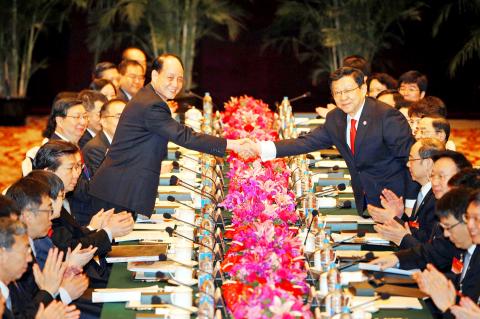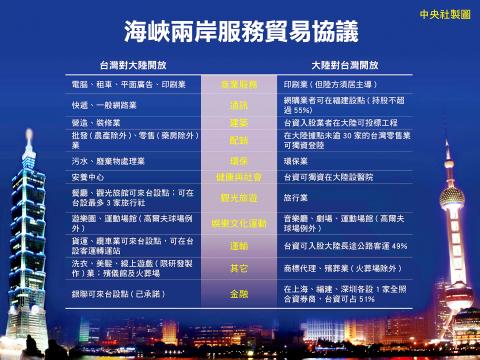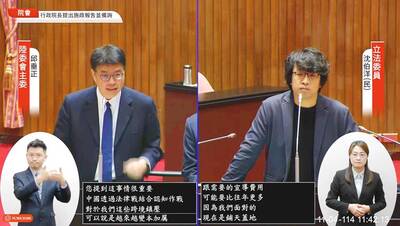The Straits Exchange Foundation and the Association for Relations Across the Taiwan Straits (ARATS) yesterday signed a cross-strait service trade agreement in Shanghai during the ninth round of cross-strait talks, opening the service sectors on both sides to further cross-strait exchanges.
Under the pact, which includes four chapters and 24 articles, 64 Taiwanese industries will be opened to Chinese investment, while China will open up 80 industries to Taiwan.
The Taiwanese industries include transportation, tourism and traditional Chinese medicine, while China will open up its finance, retail, electronics, publishing and travel sectors.

Photo: CNA
Under the agreement, Chinese investors will be allowed to open hotels in Taiwan.
Taiwan will also allow Chinese travel agencies to establish a maximum of three branches in the country and provide services to Taiwanese. However, they will not be allowed to accommodate any foreign tourists, including Chinese.
Taiwanese investors will be allowed to set up travel agencies in China, as well as open restaurants or hotels.

Photo: CNA
Chinese companies will be allowed to open beauty parlors or hair salons in Taiwan, but would only be allowed to employ Taiwanese.
While China will open its publishing industry to Taiwanese investment, Taiwan will allow Chinese companies to invest in Taiwanese businesses in the printing service industry, with a maximum of 50 percent stock ownership.
On financial services, Taiwanese companies will be allowed to invest security companies in Shanghai, in Shenzhen and Chinese-controlled Fujian Province.
In signing the pact, foundation Chairman Lin Join-sane (林中森) and ARATS Chairman Chen Deming (陳德銘) both lauded the agreement for deepening cross-strait exchanges in the service sector.
Lin said 80 percent of the deal opens the two sides’ service sectors to the same or greater degree as the Closer Economic Partnership Arrangement (CEPA) that was signed between Hong Kong and China in 2003, with 90 percent of financial services covered in the cross-strait agreement opened, just like in the CEPA.
The cross-strait service trade agreement is a major follow-up to the Economic Cooperation Framework Agreement (ECFA) and the General Agreement on Trade in Services under the WTO.
“The service trade agreement is a pact that benefits related sectors across the Taiwan Strait and promotes the interests of the public on both sides. It will result in a win-win situation for both sides,” Lin said.
After signing the pact, Taiwan and China cannot revise or cancel the agreement within the next three years.
The two sides will hold an annual meeting to review the implementation of the pact.
The agreement also includes an emergency negotiation mechanism, which gives related industries from each side the right to demand negotiations and seek solutions if the agreement negatively affects their businesses sectors.

CALL FOR SUPPORT: President William Lai called on lawmakers across party lines to ensure the livelihood of Taiwanese and that national security is protected President William Lai (賴清德) yesterday called for bipartisan support for Taiwan’s investment in self-defense capabilities at the christening and launch of two coast guard vessels at CSBC Corp, Taiwan’s (台灣國際造船) shipyard in Kaohsiung. The Taipei (台北) is the fourth and final ship of the Chiayi-class offshore patrol vessels, and the Siraya (西拉雅) is the Coast Guard Administration’s (CGA) first-ever ocean patrol vessel, the government said. The Taipei is the fourth and final ship of the Chiayi-class offshore patrol vessels with a displacement of about 4,000 tonnes, Lai said. This ship class was ordered as a result of former president Tsai Ing-wen’s (蔡英文) 2018

‘SECRETS’: While saying China would not attack during his presidency, Donald Trump declined to say how Washington would respond if Beijing were to take military action US President Donald Trump said that China would not take military action against Taiwan while he is president, as the Chinese leaders “know the consequences.” Trump made the statement during an interview on CBS’ 60 Minutes program that aired on Sunday, a few days after his meeting with Chinese President Xi Jinping (習近平) in South Korea. “He [Xi] has openly said, and his people have openly said at meetings, ‘we would never do anything while President Trump is president,’ because they know the consequences,” Trump said in the interview. However, he repeatedly declined to say exactly how Washington would respond in

WARFARE: All sectors of society should recognize, unite, and collectively resist and condemn Beijing’s cross-border suppression, MAC Minister Chiu Chui-cheng said The number of Taiwanese detained because of legal affairs by Chinese authorities has tripled this year, as Beijing intensified its intimidation and division of Taiwanese by combining lawfare and cognitive warfare, the Mainland Affairs Council (MAC) said yesterday. MAC Minister Chiu Chui-cheng (邱垂正) made the statement in response to questions by Democratic Progressive Party (DPP) Legislator Puma Shen (沈柏洋) about the government’s response to counter Chinese public opinion warfare, lawfare and psychological warfare. Shen said he is also being investigated by China for promoting “Taiwanese independence.” He was referring to a report published on Tuesday last week by China’s state-run Xinhua news agency,

‘ADDITIONAL CONDITION’: Taiwan will work with like-minded countries to protect its right to participate in next year’s meeting, the foreign ministry said The US will “continue to press China for security arrangements and protocols that safeguard all participants when attending APEC meetings in China,” a US Department of State spokesperson said yesterday, after Beijing suggested that members must adhere to its “one China principle” to participate. “The United States insists on the full and equal participation of all APEC member economies — including Taiwan — consistent with APEC’s guidelines, rules and established practice, as affirmed by China in its offer to host in 2026,” the unnamed spokesperson said in response to media queries about China putting a “one China” principle condition on Taiwan’s